
Taekwondo (TKD) and Karate are two of the most popular Asian martial arts, spread worldwide and practiced by millions of people of all ages and genders. Although these two martial arts look quite similar, there are more than a few differences, one of the key being the belt ranking system.
Karate has 8 colored belts for adults: white, yellow, orange, green, blue, purple, brown, and black. In contrast, Taekwondo has 10 belt ranks (World TKD standard): white, yellow, orange, green, purple, blue, brown, red, Jr. black, and black.
And before moving on, please note that both taekwondo and karate have multiple styles, each with its own ranking system. This means that the number of belts, colors, and promotions may differ between schools and styles. To simplify things, this article will mainly focus on the belt ranking system most commonly used for adults in taekwondo and karate, as well as their key differences.
Taekwondo Belt Ranking System
Taekwondo rank belts originate from Judo and the system developed by Kano Jigoro in the 19th century. The belt ranks are split between junior ranks and senior ranks. Junior ranks include 10 different solid-colored belts called “geup” which translates to “grade” where each one represents a level of proficiency and experience.
Since Taekwondo has multiple organizations, the number of belts as well as the color might vary from 8 to 12. For instance, World Taekwondo (WT) has 12 ranks, while the International Taekwondo Federation (ITF) has 10 ranks. Also, each color belt has multiple colored stripes representing a student’s level within a given belt rank.
Once a student earns all the belts in the junior ranks, they move to the senior ranks called “dan” which translates to “degrees” or “levels.” Senior ranks include 10 dan ranks, which are basically 10 different levels of a black belt.
Here are tables for the ITF and WT belt ranking systems that outline the student and senior ranks in Taekwondo. This simplifies the information and makes it easier to understand.
International Taekwondo Federation (ITF) Belt Ranking System:
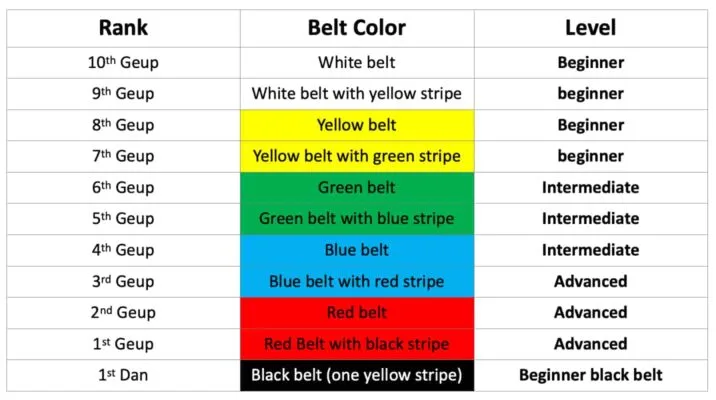
World Taekwondo (official Olympic style) belt ranking system:
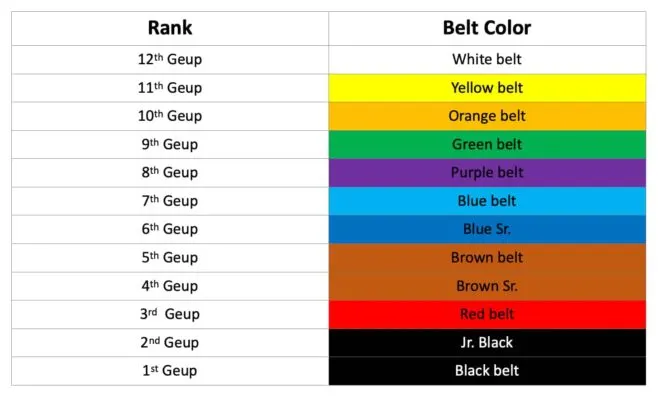
RECOMMENDED READING: What Are the Different Styles of Korean Martial Arts?
Karate Belt Ranking System
Karate belt ranks are also rooted in Judo and the color belt ranking concept developed by Kano Jigoro. The initial variation of the system emerged in 1924, when the legendary karateka and the founder of Shotokan Karate, Gichin Funakoshi, decided to adopt the judo belt system in karate.
But before moving forward, remember that karate has dozens of different styles and organizations. As a result, the exact number of belts, colors, and requirements significantly vary between the styles. But the core concept of solid-colored belt ranks and stripes within each rank remains the same.
According to the traditional Shotokan curriculum, the karate belt ranking system consists of 8 different colored belts, each of which represents proficiency and experience.
Like in Taekwondo, the system is split between student ranks called “kyu” and senior ranks known as “dan” ranks. Student ranks have 10 levels, and the ranking goes in descending order. It starts at the lowest rank, which is the 10th kyu (white belt), and goes down to the 1st kyu rank (brown). Once students earn a brown belt, they move to “Dan” ranks (black belts).
“Dan” ranks include 10 different black belts, and the ranking goes in ascending order this time. The lowest rank is the 1st-degree black belt (1st dan), and the system goes all the way up to the 10th-degree black belt (10th dan). To make it all easier to understand, here is a table explaining the “kyu” and “Dan” karate ranks.
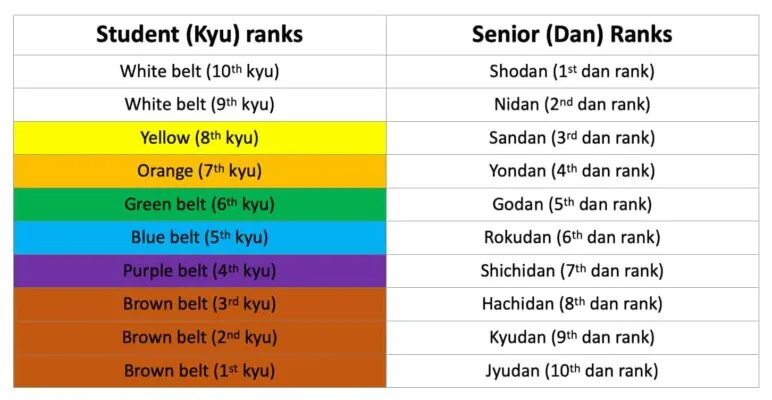
RECOMMENDED READING: What Are the Different Styles of Japanese Martial Arts?
Key Differences Between TKD and Karate Belt Ranking Systems
The biggest difference is the number of junior (kyu/geup) color belts, as karate includes 7 while Taekwondo includes 10.
Following is a detailed and easy-to-understand explanation of all the key differences between the Taekwondo and Karate belt ranking systems.
Time it takes to get a black belt
Taekwondo and Karate are quite similar in terms of difficulty and the time one needs to spend on the mat before earning a black belt rank. The exact time is based on many factors, such as individual talent for athleticism, dedication, passion, and consistency. It is also based on the style you train in, the quality of the instructors, and the criteria level.
In general, it takes between 3 and 5 years for a dedicated student to reach a black belt rank in Taekwondo. Students with average talent are supposed to go through all the geup (student) ranks within this time span, but it can also take much more than that. In some schools, students are not eligible to earn a black belt without 4 or 5 years of training.
According to the International Taekwondo Association, you need a minimum of 40 months of training, 3 times a week, to be granted a black belt.
Here’s a table easily explaining a complete timeline for achieving a TKD black belt from the start as a white belt.
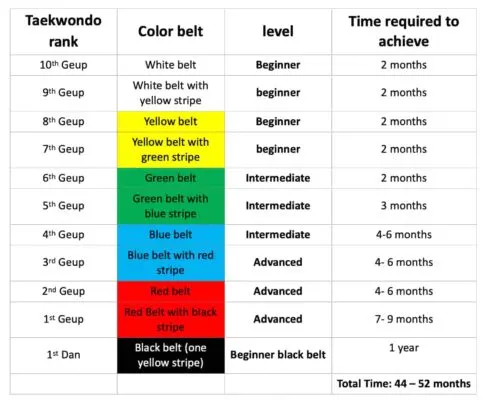
As for Karate, the time it takes to earn a black belt is very similar, between 4 and 5 years on average. However, bear in mind that the time varies between styles and organizations.
There are schools where you can earn a black belt in less than two years because the criteria and requirements are low. But you won’t be as skilled as karatekas who train in dojos that embrace traditional teaching methods and requirements.
Here’s a table easily explaining a complete timeline for achieving a Karate black belt from the start as a white belt.

Number of Katas
Both Taekwondo and Karate prioritize the practice of standardized sets of offensive and defensive movements called forms. These forms consist of precise and choreographed sequences of martial arts movements that are designed to be practiced individually.
In karate, forms are known as “katas,” while in Taekwondo, they are called “poomsae,” which is a Korean word for forms. In both arts, students spend a lot of training time doing forms because performing these pre-arranged sets of movements is included in each belt promotion testing.
So in order to progress to a higher rank, students must master all the forms to perfection and learn how to execute them in a relaxed and focused manner. Shotokan Karate, the most famous karate style, has 26 forms/katas, while Taekwondo has 24 forms/poomsae, which represent 24 hours in a day.
Here’s a table that lists the names of different katas and poomsae.
| Karate forms (katas) | ITF Taekwondo forms (poomsae) |
| Heian Shodan | Chon-Ji |
| Heian Nidan | Dan-Gun |
| Heian Sandan | Do-San |
| Heian Yondan | Won-Hyo |
| Heian Godan | Yul-Gok |
| Tekki Shodan | Joong-Gun |
| Tekki Nidan | Toi-Gye |
| Tekki Sandan | Hwa-Rang |
| Bassai Dai | Choong-Moo |
| Bassai Sho | Kwang-Gae |
| Kanku Dai | Po-Eun |
| Kanku Sho | Gae-Baek |
| Enpi | Eui-Am |
| Jion | Choong-Jang |
| Gankaku | Juche or Ko-Dang |
| Hangetsu | Sam-Il |
| Jitte | Yoo-Sin |
| Chinte | Choi-Yong |
| Sochin | Yong-Gae |
| Meikyo | Ul-Ji |
| Jiin | Moon-Moo |
| Gojushisho Dai | So-San |
| Gojushiho Sho | Se-Jong |
| Nijushiho | Tong-Il |
| Wankan | |
| Unsu |
Similarities Between Karate and Taekwondo Belt Ranks
Although these are two separate martial arts that emphasize different aspects of combat, the Karate and Taekwondo belt ranking systems share some similarities. The following is a detailed explanation of their similarities.
The same origins
Both Taekwondo and Karate have adopted the concept of color belt ranking from Judo. Although the number of belts and ranks may vary between the styles, the core concept is the same, which is why the belt ranks are so similar.
Kano Jigoro, the creator of Kodokan Judo, drew inspiration from the board game “Go” to create the first belt ranking system. The initial variation had only three colors: white, brown, and black, but the number of ranks and belts would gradually increase over the years.
Shotokan Karate was the first to follow the concept of the belt ranking system from Judo in 1924, thanks to its founder, Gichin Funakoshi, and then Taekwondo did the same in the 1950s.
Progression to the higher belts
The process of advancing to higher ranks in both Karate and Taekwondo is quite similar. Of course, the requirements are different in terms of techniques and forms because these are two different combat systems. But in order to earn a higher belt rank, students in both arts need to undergo official belt testing, which takes place every few months depending on their rank. Lower belt testing is organized every 2-3 months, while black belt testing is every 6 months to a year.
Students will first receive an invitation to take a belt promotion before attending an official test where they must perform in front of the examiners. Together with their instructors, they will focus on mastering all the required forms and other aspects for the belt rank they are trying to obtain. The exact requirements vary between styles of Karate and Taekwondo as well as the ranks.
For the lower ranks, students usually need to show proficiency in executing offensive and defensive forms, an improved level of fitness, and pass the written test related to terminology and history. Students at the higher ranks do more advanced forms, and they often spar to showcase the practical application of techniques and might also have to demonstrate their ability to break boards.
Once the board of examiners agrees that a student meets the required skill level, they will promote them to a higher rank. And this process is the same in both Karate and Taekwondo.
The same belt meaning
The belt is not just a piece of cloth martial artists wear to keep their Gi uniform in place. No, each color belt represents a rank and has a philosophical meaning. This meaning is the same across all martial arts that use the Judo belt ranking concept, including karate and taekwondo.
Here’s what each color of belt represents:

White belt — the plant is born and breaks through the ground to meet the white sunlight. This symbolizes the beginning and the students’ desire to learn.
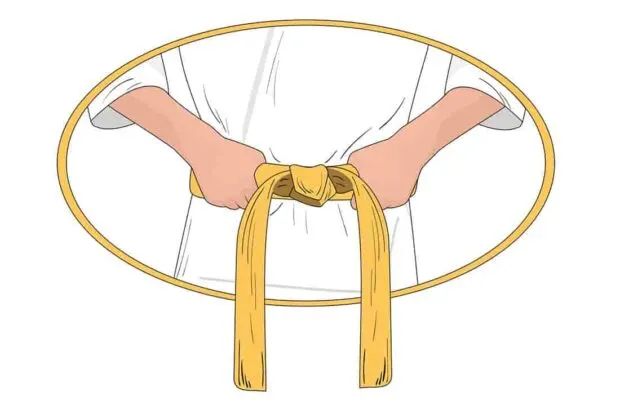
Yellow belt — the plant is exposed to the first beams of sunlight. It symbolizes a student who has learned the basic moves.

Orange belt — the warmth of the sun gets hotter, and it becomes difficult for the plant to grow. This symbolizes students’ struggles as the training and techniques get more difficult.
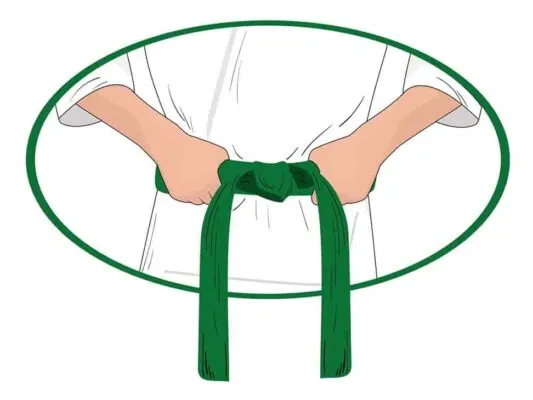
Green belt — the plant gets greener, and it starts growing new leaves. This means that a student is growing and mastering the basics at a faster rate.
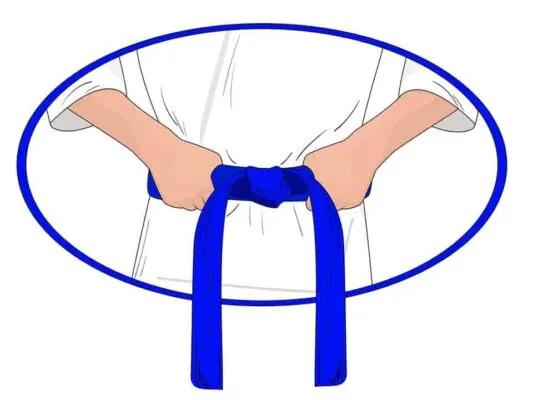
Blue belt — the plant is growing taller and is reaching the blue sky above. Students’ martial art knowledge is rapidly expanding.
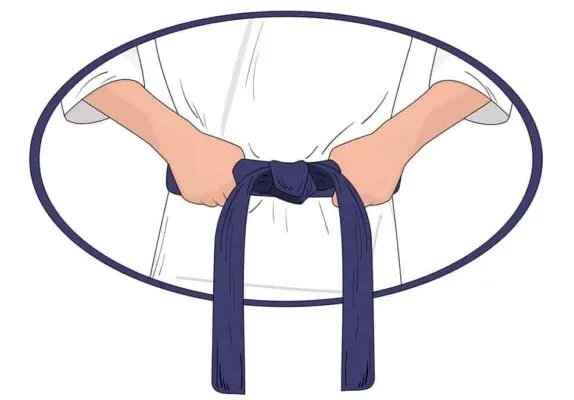
Purple belt — the sun sets, and the day slowly turns to night, with the blue sky darkening to purple. A student has mastered all the basics and is moving to the advanced stage of learning.

Brown belt — as the darkness increases, the plant bows down to the brown soil and is ready for harvesting. Students are maturing as martial artists and getting highly proficient in executing complex techniques.

Black belt — the plant dies, and the new one will grow. This means that every end is another beginning. Students have learned a lot, but their martial art journey has only begun.
